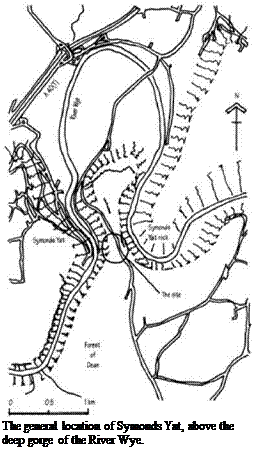Symonds Yat is a site in the former Royal Forest of Dean in Gloucestershire, England. It is managed by Forest Enterprise, the national forestry management agency in Britain, and is one of a number of recreation sites offering recreation in an ancient forest setting. It is probably the most heavily visited site in a British forest, and yet it is quite small in area. The main purpose of visiting Symonds Yat is to look at a dramatic view over the River Wye gorge. In addition, rock climbing, wildlife watching, picnicking and walking trails are other possible activities.
Symonds Yat rock has been an established tourist attraction since the eighteenth century. It was promoted by William Gilpin in 1782 and later espoused by William Wordsworth and the romantic poets. Before road access was possible, visitors arrived by boat along the River Wye, and later Victorians and Edwardians came by train and charabanc (early minibuses). During the late 1950s and 1960s car ownership expanded, and visitor numbers dramatically increased. At first the provision for car parking was ad hoc, little design being undertaken. Managers tried merely to keep the site reasonably undamaged. Access from the narrow and steep public road was always difficult. There were concerns over safety because of the high cliffs surrounding the site, and risks of damage to the ramparts, which are part of its history as an Iron Age promontory fort.
 |
Wear and tear of the site was severe, the ground surface at the main viewpoint being eroded down to bare rock by the impact of thousands of human feet. Access for people with disabilities was difficult, and the toilet capacity was seriously inadequate. There were reports of queues at the ladies’ toilets regularly being 15 or more at peak times.
By the late 1980s, despite some work to give the area a better access and parking layout during the 1970s, the situation was
becoming out of hand. A survey in 1988 showed that 400 000 visitors a year came to the site. These visitors usually stayed for a relatively short time but the sheer wear and tear, congestion and damage from traffic queues meant that the experience gained by these visitors was of inadequate quality.



